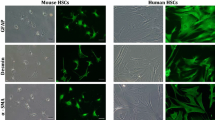Abstract
Purpose
To clarify the functional involvement of hedgehog signaling, especially sonic hedgehog (Shh) and glioma-associated oncogene (Gli)-1 which are known to play an important role in embryonic development and cancer, in the regeneration of a hepatectomized rat liver.
Methods
Six-week-old male Wistar rats were subjected to 70 or 90 % hepatectomy (Hx). Animals were killed at 24, 48 and 72 h after Hx. The liver/body weight ratio was measured as an index of regeneration. Formalin-fixed liver samples were embedded in paraffin, stained for immunohistochemistry with proliferating cell nuclear antigen (PCNA) antibody, and the labeling index was calculated. Immunohistochemistry was also performed with Shh and Gli-1 antibodies.
Results
The liver/body weight ratio gradually increased in both the 70 and 90 % Hx, groups. The hepatocytes were strongly stained for PCNA at 24 h after Hx. Non-parenchymal cells were gradually stained by PCNA from 24 to 72 h after Hx. Shh and Gli-1 expression in hepatocytes was higher after 24 h than at other times and then gradually decreased. Shh and Gli-1 expression in non-parenchymal cells increased gradually, and was found mainly in liver zone I at 72 h after 70 and 90 % Hx.
Conclusions
The expression of both markers suggested that Shh signaling contributes to tissue reconstruction after Hx.




Similar content being viewed by others
References
Ingham PW, McMahon AP. Hedgehog signaling in animal development: paradigms and principles. Genes Dev. 2001;15:3059–87.
Hooper JE, Scott MP. Communicating with Hedgehogs. Nat Rev Mol Cell Biol. 2005;6:306–17.
Jiang J, Hui CC. Hedgehog signaling in development and cancer. Dev Cell. 2008;15:801–12.
Miyaji T, Nakase T, Iwasaki M, et al. Expression and distribution of transcripts for sonic hedgehog in the early phase of fracture repair. Histochem Cell Biol. 2003;119:233–7.
Fan H, Khavari PA. Sonic hedgehog opposes epithelial cell cycle arrest. J Cell Biol. 1999;147:71–6.
Sanchez P, Hernandez AM, Stecca B, et al. Inhibition of prostate cancer proliferation by interference with SONIC HEDGEHOG-GLI1 signaling. Proc Natl Acad Sci USA. 2004;101:12561–6.
Sheng T, Li C, Zhang X, et al. Activation of the hedgehog pathway in advanced prostate cancer. Mol Cancer. 2004;3:29.
Fan L, Pepicelli CV, Dibble CC, et al. Hedgehog signaling promotes prostate xenograft tumor growth. Endocrinology. 2004;145:3961–70.
Thayer SP, di Magliano MP, Heiser PW, et al. Hedgehog is an early and late mediator of pancreatic cancer tumorigenesis. Nature. 2003;425:851–6.
Ohta M, Tateishi K, Kanai F, et al. p53-Independent negative regulation of p21/cyclin-dependent kinase-interacting protein 1 by the sonic hedgehog-glioma-associated oncogene 1 pathway in gastric carcinoma cells. Cancer Res. 2005;65:10822–9.
Oniscu A, James RM, Morris RG, et al. Expression of Sonic hedgehog pathway genes is altered in colonic neoplasia. J Pathol. 2004;203:909–17.
Qualtrough D, Buda A, Gaffield W, et al. Hedgehog signalling in colorectal tumour cells: induction of apoptosis with cyclopamine treatment. Int J Cancer. 2004;110:831–7.
Fausto N. Liver regeneration. J Hepatol. 2000;32:19–31.
Tanimizu N, Miyajima A. Molecular mechanism of liver development and regeneration. Int Rev Cytol. 2007;259:1–48.
Yoshida D, Akahoshi T, Kawanaka H, et al. Roles of vascular endothelial growth factor and endothelial nitric oxide synthase during revascularization and regeneration after partial hepatectomy in a rat model. Surg Today. 2011;41:1622–9.
Jung Y, McCall SJ, Li YX, et al. Bile ductules and stromal cells express hedgehog ligands and/or hedgehog target genes in primary biliary cirrhosis. Hepatology. 2007;45:1091–6.
Yang L, Wang Y, Mao H, et al. Sonic hedgehog is an autocrine viability factor for myofibroblastic hepatic stellate cells. J Hepatol. 2008;48:98–106.
Omenetti A, Yang L, Li YX, et al. Hedgehog-mediated mesenchymal–epithelial interactions modulate hepatic response to bile duct ligation. Lab Invest. 2007;87:499–514.
Sicklick JK, Li YX, Choi SS, et al. Role for hedgehog signaling in hepatic stellate cell activation and viability. Lab Invest. 2005;85:1368–80.
Higgins GM, Anderson RM. Experimental pathology of the liver. Arch Pathol. 1931;12:186–202.
Gaub J, Iversen J. Rat liver regeneration after 90 % partial hepatectomy. Hepatology. 1984;4:902–4.
Zieve L, Anderson WR, Lindblad S. Course of hepatic regeneration after 80% to 90 % resection of normal rat liver. Comparison with two-lobe and one-lobe hepatectomy. J Lab Clin Med. 1985;105:331–6.
Nagamine K, Kubota T, Togo S, et al. Beneficial effect of hyperbaric oxygen therapy on liver regeneration after 90 % hepatectomy in rats. Eur Surg Res. 2004;36:350–6.
Sakamoto T, Liu Z, Murase N, et al. Mitosis and apoptosis in the liver of interleukin-6-deficient mice after partial hepatectomy. Hepatology. 1999;29:403–11.
Li Y, Zhang H, Choi SC, et al. Sonic hedgehog signaling regulates Gli3 processing, mesenchymal proliferation, and differentiation during mouse lung organogenesis. Dev Biol. 2004;270:214–31.
Lin N, Tang Z, Deng M, et al. Hedgehog-mediated paracrine interaction between hepatic stellate cells and marrow-derived mesenchymal stem cells. Biochem Biophys Res Commun. 2008;372:260–5.
Omenetti A, Popov Y, Jung Y, et al. The hedgehog pathway regulates remodelling responses to biliary obstruction in rats. Gut. 2008;57:1275–82.
Conflict of interest
We declare that we have no conflicts of interest.
Author information
Authors and Affiliations
Corresponding author
Rights and permissions
About this article
Cite this article
Hanaoka, J., Shimada, M., Utsunomiya, T. et al. Significance of sonic hedgehog signaling after massive hepatectomy in a rat. Surg Today 43, 300–307 (2013). https://doi.org/10.1007/s00595-012-0248-z
Received:
Accepted:
Published:
Issue Date:
DOI: https://doi.org/10.1007/s00595-012-0248-z




